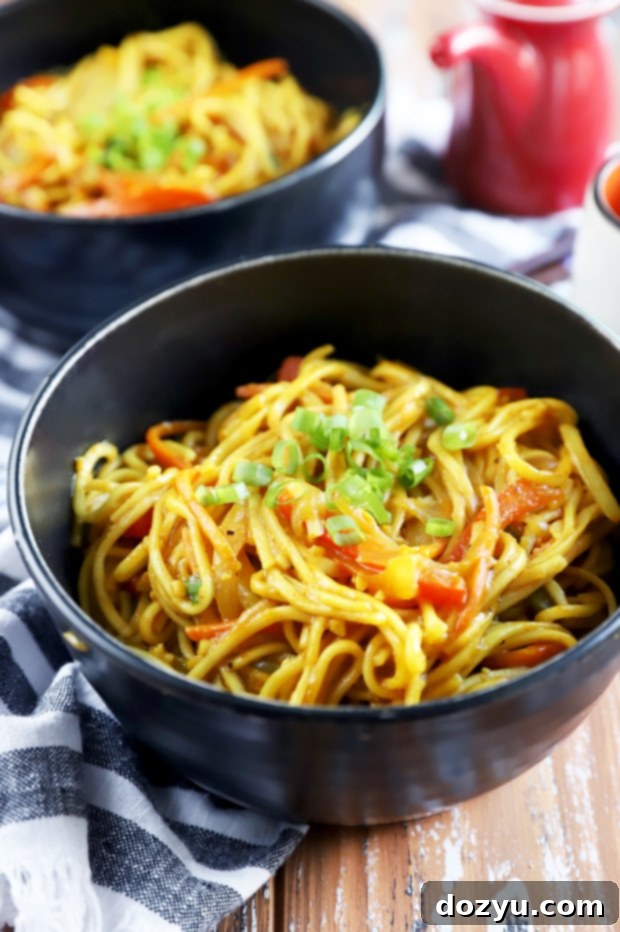Speedy & Flavorful Singapore Street Noodles: Your 15-Minute Weeknight Meal Solution
Craving an explosion of Asian flavors without the long wait? These Singapore Street Noodles are your answer! Simple to prepare, incredibly flavorful, with a perfect balance of sweet and a hint of spice, this entire dish comes together in just 15 minutes. It’s a fantastic option for a dedicated vegetarian night, but also wonderfully versatile for utilizing leftover chicken, shrimp, pork, or beef to create a truly personalized and satisfying meal. Get ready to elevate your weeknight dinner routine with this quick, vibrant, and utterly delicious noodle dish!
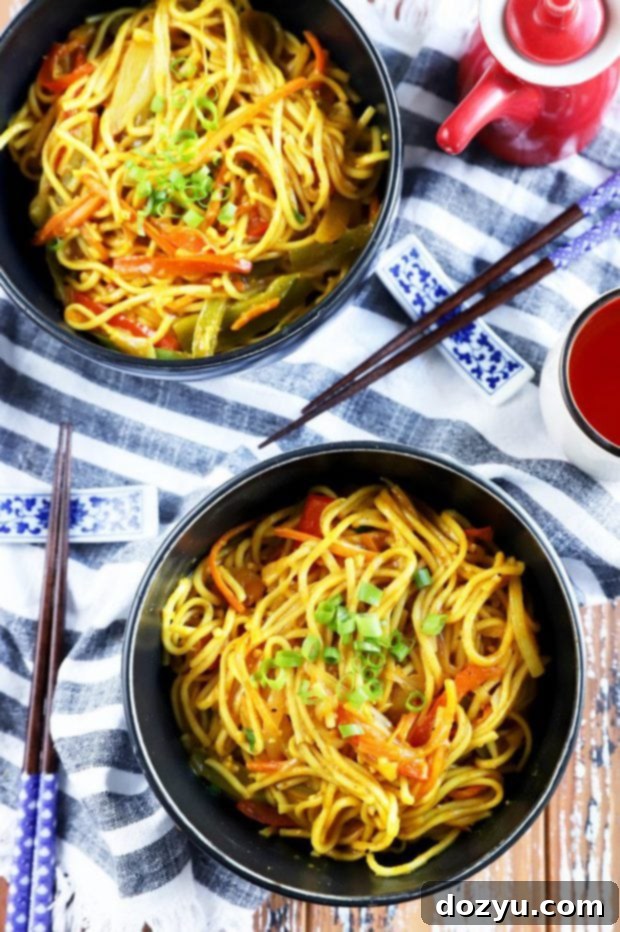
Table of Contents
Toggle
About These Singapore Street Noodles
My first introduction to the vibrant world of Singapore Street Noodles came during a captivating episode of Top Chef. The finalists were immersed in Singapore’s famed hawker centers, indulging in a dizzying array of street food. The sheer energy and diverse flavors of that bustling market made a lasting impression, and among the many delectable dishes, Singapore street noodles truly captured my imagination.
While the name suggests an origin in Singapore, culinary history buffs often debate its true birthplace, with many claiming it hails from Hong Kong. Regardless of its exact roots, this dish has become a beloved staple in Asian cuisine, celebrated for its unique flavor profile. The most distinctive feature, and arguably what gives these noodles their signature golden hue, is the generous inclusion of curry powder in the sauce. This spice blend infuses the dish with an aromatic warmth and a subtly complex taste that sets it apart from other noodle preparations.
What makes this Singapore street noodle recipe particularly appealing is its incredible adaptability. It’s a culinary canvas ready for your personal touch. Whether you’re a devout vegetarian seeking a plant-based feast or looking to incorporate protein, these noodles rise to the occasion. They provide an excellent opportunity to transform leftover meats – think shredded chicken, tender pork, or thinly sliced beef – into a brand new, exciting meal. For seafood lovers, a handful of fresh shrimp can be quickly cooked and tossed in at the final stage, adding another layer of texture and flavor. This flexibility makes it not just a quick weeknight dinner, but also a smart way to reduce food waste and explore different flavor combinations.
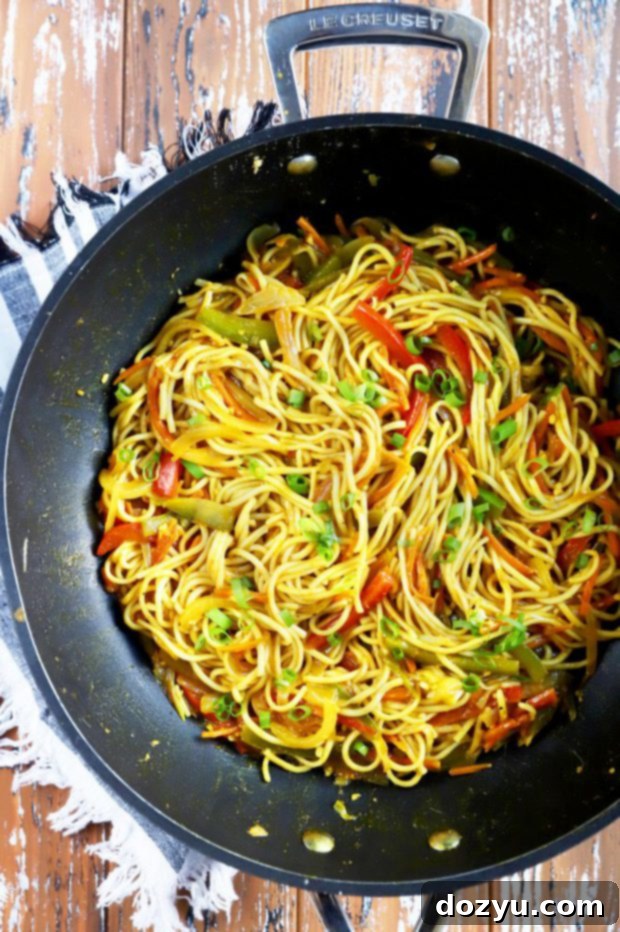
Key Ingredients for Authentic Flavor
Crafting truly delicious Singapore Street Noodles starts with selecting the right ingredients. Here’s a closer look at what you’ll need and why each component is essential to achieving that authentic, unforgettable taste:
- Thin Rice Noodles (Vermicelli): These delicate noodles are the backbone of the dish. Also known as rice vermicelli, their fine texture is perfect for absorbing the rich sauce and blending harmoniously with the other ingredients. Be sure to cook them according to package directions, typically just until al dente, to avoid them becoming mushy.
- Sesame Oil: Derived from toasted sesame seeds, this oil boasts a profoundly nutty and aromatic flavor. It’s a powerful ingredient, so use it judiciously as a little goes a long way. Too much can easily overpower the other subtle notes in the dish.
- Bell Peppers: For both visual appeal and a delicious burst of sweet-crisp flavor, I highly recommend using two different colors of bell peppers. Orange, red, and yellow bell peppers work wonderfully, adding vibrant hues and a refreshing crunch that contrasts beautifully with the soft noodles.
- Shallots: If you’re familiar with my recipes, you know my love for shallots! These elegant members of the onion family offer a milder, sweeter, and more nuanced flavor than regular onions. They add depth without the harshness, making them perfect for this delicate noodle dish.
- Sweet Onion: Complementing the shallots, a sweet onion brings another layer of mild sweetness to the sautéed vegetables. Its flavor is less pungent and more mellow compared to white or red onions, ensuring a smooth integration into the overall profile.
- Carrots: Whether you prefer to peel and shred fresh carrots yourself for maximum freshness or opt for the convenience of pre-shredded carrots, they add a touch of natural sweetness, vibrant color, and pleasant texture to the noodles.
- Fresh Ginger: You’ll need ginger in two forms for this recipe. Roughly chopped ginger is added to the wok with the vegetables, infusing the oil with its zesty warmth. For the sauce, minced ginger (or a convenient ginger paste, which I often prefer for its ease of use and consistent flavor) provides a more concentrated and smooth ginger essence.
- Fresh Garlic: Similar to ginger, garlic plays a dual role. Roughly chopped cloves are sautéed with the vegetables to build a foundational aromatic base, while minced garlic (or garlic paste) is incorporated into the sauce for a more potent garlicky punch. This dual application ensures a rich, layered garlic flavor throughout the dish.
- Mirin:
What is Mirin?
Mirin is a subtly sweet Japanese rice wine, similar to sake but with a lower alcohol content and higher sugar content. It’s one of my absolute favorite ingredients for Asian-inspired dishes, contributing a delicate sweetness and umami depth. I highly recommend keeping it in your pantry! If mirin isn’t readily available, suitable substitutes include rice vinegar (add a pinch of sugar to balance) or dry white wine, though the flavor profile will be slightly different.
- Green Onion (Scallions): Sliced green onions are primarily used as a fresh garnish, providing a mild oniony bite and a beautiful pop of green to finish the dish.
- Broth: Use a low-sodium chicken or vegetable broth as the liquid base for the sauce. Opting for low-sodium allows you to control the overall saltiness, adjusting it to your preference later.
- Soy Sauce: I prefer using low-sodium soy sauce for the same reason as the broth – it gives you greater control over seasoning. However, you can certainly use full-sodium soy sauce if that’s what you typically have on hand, just be mindful when adding extra salt.
- Curry Powder and Turmeric Powder: These two spices are the heart and soul of Singapore Street Noodles, giving them their characteristic golden color and aromatic curry flavor. Curry powder provides a warm, earthy blend, while turmeric adds a distinctive peppery, slightly bitter note and intensifies the yellow hue. Always strive for high-quality versions of these spices for the best results.
- Sriracha: This beloved hot sauce is where the “spicy” element comes into play! The amount listed in the recipe provides a pleasant kick, but feel free to adjust. Add more to truly amp up the heat level if you like your noodles extra fiery.
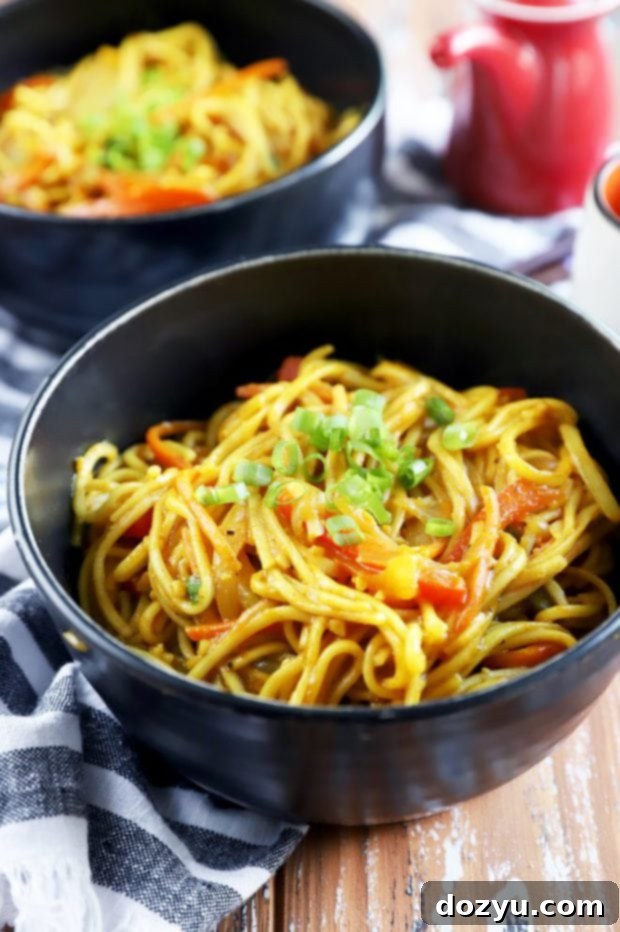
Essential Kitchen Tools
One of the beauties of this Singapore Street Noodles recipe is its simplicity, extending even to the minimal kitchen equipment required. To ensure a smooth and efficient cooking process, have these basic tools ready:
- Chef’s Knife: A sharp, reliable chef’s knife is indispensable for quickly and uniformly slicing all the vegetables and aromatics for this veggie-loaded dish. Precision cuts contribute to even cooking and a beautiful presentation.
- Cutting Board: Pair your chef’s knife with a sturdy and spacious cutting board. An organic bamboo cutting board, for example, offers a stable surface and is gentle on your knife blades.
- Wok or Large Nonstick Skillet: The entire stir-fry comes together in a single pan. While a traditional wok is ideal for its high heat retention and sloped sides that make tossing easy, a large nonstick skillet with high sides will also work perfectly. The nonstick surface ensures your noodles and vegetables don’t stick, making for easier cooking and cleanup.
- Mixing Bowls: You’ll need a couple of small mixing bowls – one for preparing the flavorful sauce and another for whisking together the cornstarch slurry. Stainless steel mixing bowls are durable and versatile.
- Whisk: A good whisk, such as a French wire whisk, is essential for smoothly combining the sauce ingredients and the cornstarch slurry, ensuring no lumps.
Looking for more delicious noodle inspiration? Discover these other amazing recipes: Instant Pot Bolognese | Flank Steak with Creamy Kale Peanut Noodles | Stir Fry Pasta | Gochujang Noodles with Chicken and Greens | Curry Udon
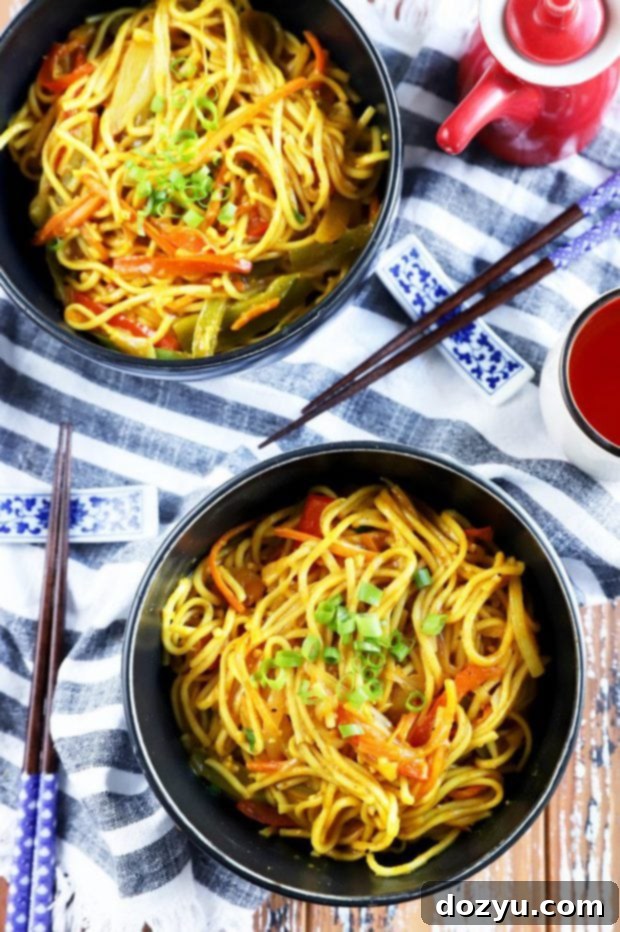
Crafting Your Delicious Singapore Street Noodles!
Get ready for a flavor-packed, lightning-fast cooking experience! Follow these simple steps to bring your amazing Singapore Street Noodles to life in just 15 minutes.
Prepare the Sauce and Slurry
First, let’s get our flavor bases ready. In a small mixing bowl, combine all the ingredients listed for the sauce – this includes your broth, soy sauce, curry powder, turmeric, mirin, minced garlic, minced ginger, and sriracha. Whisk these together until they are thoroughly blended and the spices are well-distributed. Set this aromatic sauce aside.
In a separate, even smaller bowl, prepare your cornstarch slurry. Whisk together the cornstarch and water until smooth. This slurry will be added later to thicken our sauce, giving it that perfect clingy consistency. Set this aside as well.
Cook the Noodles to Perfection
Bring a large pot of lightly salted water to a rolling boil. Carefully add your thin rice noodles (vermicelli) and cook them precisely according to the package directions. Rice noodles cook very quickly, often in just 2-3 minutes, so keep a close eye on them to prevent overcooking. They should be tender but still have a slight bite – al dente. Once cooked, immediately drain the noodles and give them a quick rinse with cold water to stop the cooking process and prevent them from sticking together. Set them aside while you prepare the vegetables.
Sauté Your Vibrant Veggies
Heat the sesame oil in your wok or large nonstick skillet over medium-high heat. You’ll know the oil is ready when it starts to shimmer slightly. Add the thinly sliced bell peppers, shallots, onion, and shredded carrots to the hot pan. Cook these vegetables, tossing them occasionally, for about 5 to 8 minutes, or until they have softened slightly but still retain a pleasant crunch. We’re aiming for tender-crisp, not soggy!
Next, stir in the roughly chopped fresh ginger and garlic. Continue to cook for another 1 to 2 minutes, until these aromatics become wonderfully fragrant. Be careful not to burn the garlic. Once fragrant, push all the cooked vegetables over to one side of the wok or skillet, creating an empty space in the center of the pan.
Bring It All Together
With the vegetables pushed aside, pour your prepared sauce mixture into the empty side of the pan. Give the cornstarch slurry a quick re-whisk (it can settle) and then pour it into the sauce as well. Allow the sauce to cook for about 2 minutes, stirring gently, until it begins to bubble and thicken to a desirable consistency. It should be rich and slightly glossy.
Now, bring the cooked vegetables back into the sauce, stirring to combine. Finally, add your drained rice noodles to the pan. Using tongs or two spatulas, gently toss everything together until the noodles are thoroughly coated with the vibrant, curried sauce and mixed with all the colorful vegetables. Taste the dish and season with additional salt and pepper as needed. Serve your delicious Singapore Street Noodles immediately, garnished with a generous sprinkle of fresh sliced scallions on top for a final flourish of flavor and color!
Need some more inspiration for dinner this week? Check out my main dish recipe page!
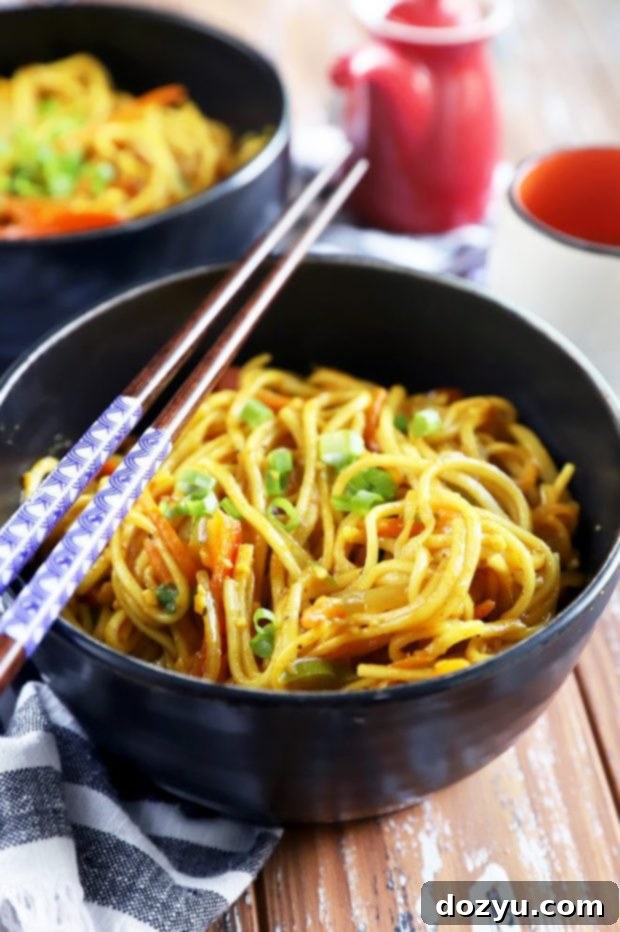
Pro Tips for Singapore Noodle Success
While this recipe is designed to be quick and straightforward, a few expert tips can elevate your Singapore Street Noodles to restaurant-quality status:
- Master the Mise en Place: This recipe truly lives up to its “15-minute” promise if you prep all your ingredients beforehand. “Mise en place” (everything in its place) is key for stir-fries. Chop all your vegetables, mince your aromatics, and measure out your sauce ingredients and slurry before you even turn on the heat. This way, the cooking process flows smoothly and rapidly, preventing anything from overcooking while you’re scrambling for the next ingredient.
- Customize with Protein: As mentioned, these noodles are incredibly versatile. To transform this into a heartier meal, consider adding your favorite protein.
- Chicken or Pork: Shredded cooked chicken or pork can be tossed in with the vegetables during the last few minutes of cooking to warm through.
- Shrimp: Fresh shrimp cook very quickly. Add them to the wok after the vegetables are softened and cook for 2-3 minutes per side until pink and opaque, then proceed with the sauce.
- Beef or Tofu: Thinly sliced steak or firm tofu (pressed, cubed, and pan-fried until crispy) can also be added. Cook beef quickly before the vegetables, or add tofu with the veggies.
- Boost Your Veggie Intake: Don’t hesitate to load up on more vegetables! This is a great way to add extra nutrients, color, and texture. Consider stirring in:
- Shredded cabbage for added crunch.
- Fresh bean sprouts for a crisp, refreshing element.
- Snow peas or snap peas for a bright green color and sweet bite.
- Broccoli florets or sliced mushrooms can be added with the other hardier vegetables.
- Don’t Overcook the Noodles: Rice vermicelli noodles cook quickly. Overcooked noodles become gummy and break apart easily. Stick to the package instructions and err on the side of slightly undercooking, as they will finish cooking when tossed in the hot sauce.
- Taste and Adjust Seasoning: Always taste your dish before serving. Depending on your broth and soy sauce, you might need to adjust the salt, add a touch more sriracha for heat, or even a squeeze of lime juice for brightness.
- High Heat is Your Friend: For a true stir-fry, cook your vegetables over medium-high to high heat. This ensures they caramelize slightly and maintain a crisp-tender texture, rather than steaming.
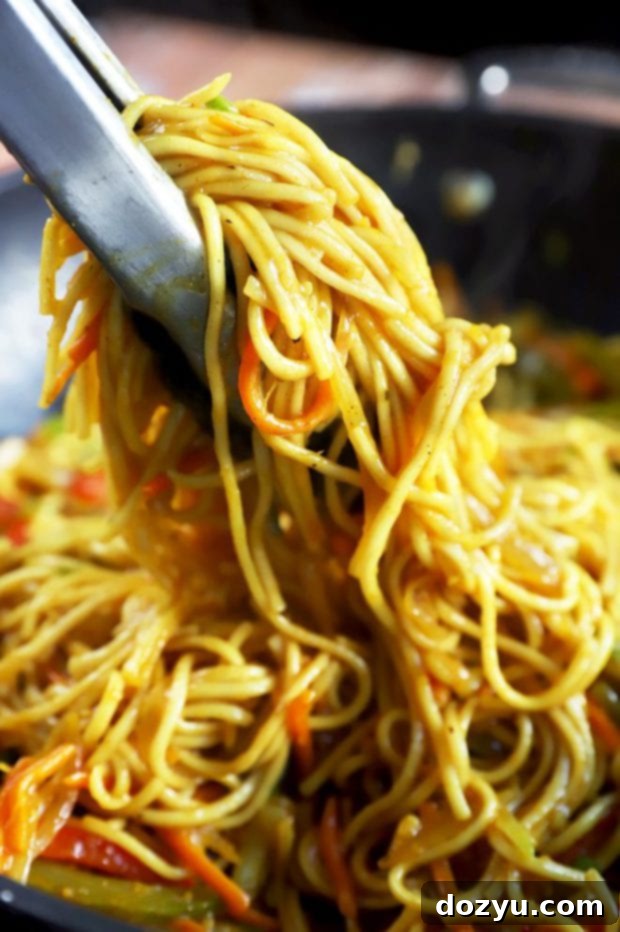
What Defines the Taste of Singapore Street Noodles?
Singapore Street Noodles offer a truly unique and captivating flavor experience. Imagine a delightful fusion of familiar Asian noodle dishes like Lo Mein or Pad Thai, but with a distinctive and aromatic twist. The defining characteristic is undeniably the curry powder, which infuses the entire dish with a warm, earthy, and mildly exotic essence. The result is a complex flavor profile that dances on your palate: it’s slightly spicy from the sriracha, savory and salty from the soy sauce, subtly tangy from the mirin, and just a touch sweet, creating a harmonious balance that is incredibly addictive.
Unlike a traditional Thai curry, these noodles aren’t swimming in a rich, soupy sauce. Instead, they are coated in a luscious, creamy curry sauce that clings beautifully to each strand of noodle and every piece of vegetable. This ensures every bite is packed with that intricate curry flavor without being overly heavy. The texture is equally important – a satisfying combination of tender rice noodles, crisp-tender vegetables, and the smooth, flavorful sauce makes for a truly delightful culinary journey.
How to Customize Your Spice Level
The beauty of cooking at home is being able to tailor dishes to your exact preferences, and Singapore Street Noodles are no exception when it comes to heat! If you love a fiery kick, there are several ways to turn up the spice level:
- More Sriracha: The easiest and most straightforward method is to simply add more Sriracha hot sauce to your curry sauce mixture. Its familiar garlicky-chili flavor integrates seamlessly without overpowering the other ingredients. Taste as you go to hit your ideal level of heat.
- Fresh Chili Peppers: For a more intense and fresh spice, finely mince a bird’s eye chili, serrano, or even a jalapeño (removing seeds for less heat) and sauté it with your other vegetables and aromatics.
- Red Chili Flakes: A sprinkle of red chili flakes can be added to the wok with the vegetables or stirred into the sauce for an extra layer of heat that slowly builds.
- Spicy Curry Powder: Some curry powders are naturally spicier than others. If you frequently enjoy hot dishes, seek out a “hot” curry powder blend for a foundational heat.
For another creamy and spicy noodle dish, be sure to check out this fantastic kimchi udon recipe!

Finally, if you whip up this incredible Singapore Street Noodles recipe, please do me a huge favor and give it a rating or drop a comment below! I genuinely love hearing from all of you when you try my recipes, and I make sure to respond to every single comment. Don’t hesitate to ask any questions you might have too!
Oh, and be sure to tag me on Instagram if you share your creations! Seeing these recipes come to life in your homes is truly my favorite part – it honestly means the world to me!
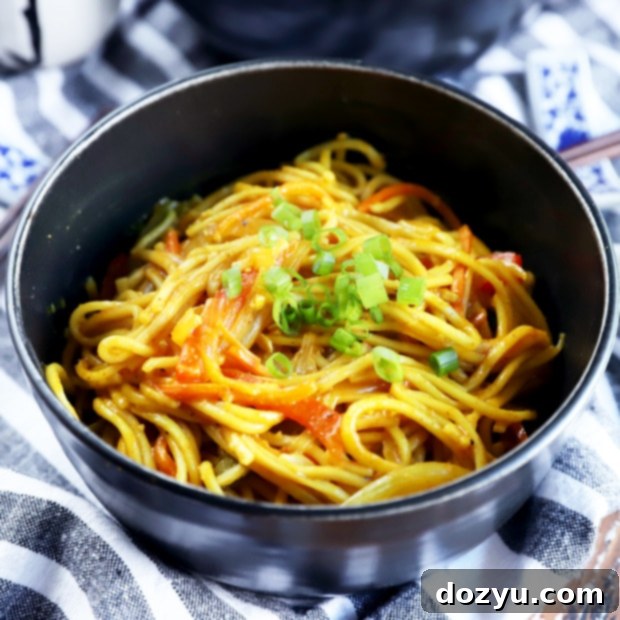
Singapore Street Noodles
5 minutes
10 minutes
15 minutes
Equipment
-
Wusthof Knife Set
-
Organic Bamboo Cutting Board
-
French Wire Whisk
-
Stainless Steel Mixing Bowls
-
Le Creuset 12″ Stir Fry Pan
Ingredients
- 8 ounces thin rice noodles (vermicelli)
- 1 tablespoon sesame oil
- 2 bell peppers (e.g., orange, red, yellow) thinly sliced
- 2 shallots thinly sliced
- 1 large sweet onion cut into thin strips
- 1/2 cup shredded carrots
- 1 tbsp fresh ginger roughly chopped
- 4 cloves garlic roughly chopped
- sliced green onions (scallions) for topping
- 1 cup low sodium chicken or vegetable broth
- 1/4 cup low sodium soy sauce
- 2 tsp curry powder
- 1/2 tsp turmeric powder
- 3 tablespoons mirin
- 2 teaspoons minced garlic
- 1 teaspoon minced ginger (or ginger paste)
- 1 Tbsp Sriracha (adjust to taste)
- 1/2 tsp cornstarch
- 2 tsp water
Instructions
-
In a small bowl, whisk together all ingredients for the sauce until well combined. Set aside.
-
In a separate small bowl, whisk together the cornstarch and water to create the slurry. Set aside.
-
Bring a large pot of water to a boil and cook the thin rice noodles according to package directions (typically 2-3 minutes). Drain immediately and rinse with cold water to prevent sticking. Set aside.
-
Heat sesame oil in a wok or large nonstick skillet over medium-high heat. Once the oil is shimmering, add the bell peppers, shallots, onion, and carrots. Cook the vegetables, stirring occasionally, until softened yet still crisp, about 5 to 8 minutes.
-
Stir in the roughly chopped ginger and garlic, cooking for another 1 to 2 minutes until fragrant.
-
Push the cooked vegetables to one side of the pan, creating an empty space. Pour the prepared sauce mixture and the cornstarch slurry into the empty side. Cook for about 2 minutes, stirring, until the sauce thickens slightly and becomes glossy. Then, stir the vegetables into the thickened sauce.
-
Add the drained noodles to the pan. Using tongs, toss the noodles, vegetables, and sauce together until everything is evenly coated and well combined.
-
Taste the noodles and season with additional salt and pepper as desired. Garnish generously with sliced green onions (scallions) and serve immediately for the best flavor and texture.
Asian
Pasta
